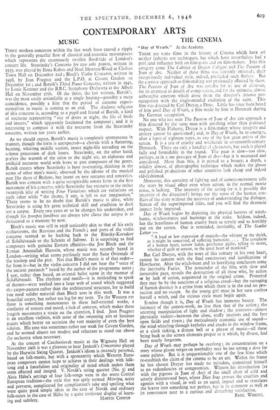THE CINEMA
"Day of 1Vrath." At the Academy.
THERE are some films in the history of Cinema which have set ne:ther fashions nor techniques, but which have nevertheless had a profound influence both on film-goers and on film-makers. Into this category come The Cabinet of Doctor Caligari and The Passion of pan of Arc. Neither of these films was slavishly imitated ; their exceptionally individual style, indeed, precluded such flattery. But the c_eative approach to film-making was profoundly affected by them. The Passion of Joan of Arc was notable for its use of close-up, for its attention to details of compcs.tion, and for the intimate, almost unbearab!e emotion which arose from the director's intense pre- occupation with the single-minded exaltation of the saint. This film was directed by Carl Dreyer, a Dane. Little has since been heard of him until Day of Wrath, a film made by him in Denmark during the German occupation.
No one who has seen The Passion of Joan of Arc can approach a film directed by the same man with anything other than profound respect. With Flaherty, Dreyer is a film-maker whose integrity and artistry cannot be questioned ; and, in Day of Wrath, he re-emerges, after a lapse of eighteen years, as one of the few great artists of the screen. It is a tale of cruelty and witchcraft in seventeenth-century Denmark. There are only a handful of characters, but each is played fully and formidably in the round. The pace is slow—too slow, perhaps, as in some passages of Joan of Arc—but it is measured and considered. More than this, it is geared to a beauty, a depth, a solidity almost, of photographic technique which makes the glossy and polished productions of other countries look cheap and indeed old-fashioned.
Moreover, this certainty of lighting and of camera-movement tells the story by visual effect even when action, in the normal movie sense, is lacking. The intensity of the acting (or is it possibly the intensity of the direction?) brings out the sense of the human con- flicts of the story without the necessity of understanding the dialogue. Screen off the superimposed titles, and you will find the dramatic impact little impaired.
Day of Wrath begins by depicting the physical horrors of witch- hunts, witch-tortures and burnings at the stake. Seldom, indeed, has the beastliness of human cruelty been so tersely and so horribly put on the screen. One is reminded, inevitably, of The Scarlet Letter :— " A loud or low expression of anguish—the whisper or the shriek, as it might be conceived, of suffering humanity. . . . The complaint of a human heart, sorrow laden, perchance guilty, telling its secret, whether of guilt or sorrow, to the great heart of mankind."
But Carl Dreyer, with the woes of this century in his own heart, cannot be content with the final sweetnesses and justifications of Hawthorne. After the witch-hunt and its horrifying conclusion come the inevitable Furies. The remainder of the film, with slow and inexorable pace, reveals the destruction of all those who, by action or by lack of action, acquiesced in the original crime. Protected they may be by the sanctions of a religious creed—but the outraging of human decency is a crime from which there is in the end no pro- tection and no escape. So the young girl must in her turn confess herself a witch, and the vicious cycle must begin again.
Sombre though it is, Day of Wrath has immense beauty. The intimacy of the camera-work, no less than that of the action ; the unerring manipulation of light and shadow ; the contrasts—almost
physically violent—between the close, stuffy interiors and the free open fields and rivers ; the meticulously economic use of sound— the wind whistling through keyholes and cracks in the window frame, or a clock ticking, a distant bell or a phrase of music—all these bring back to the screen elements proper to it which, by disuse, had been nearly forgotten.
Day of Wrath may perhaps be overlong ; its concentration on a
story whose gloom verges on morbidity may be too strong a dose for some palates. But it is unquestionably one of the few films which re-establish the claim of the cinema to be an art. Within the frame he has chosen Dreyer has made no mistakes, committed himself to no redundancies or compromises. Witness his introduction (as with the pigeons in Joan of Arc) of the small choir of cold and utterly disinterested boys, whose Dies Irae crosses the cruelties and agonies with a visual, as well as an aural, impact and so translates the horror into something not perfect, but in its comment as well as its remoteness near to a curious and disturbing satisfaction.
BASIL WRIGHT.


































 Previous page
Previous page